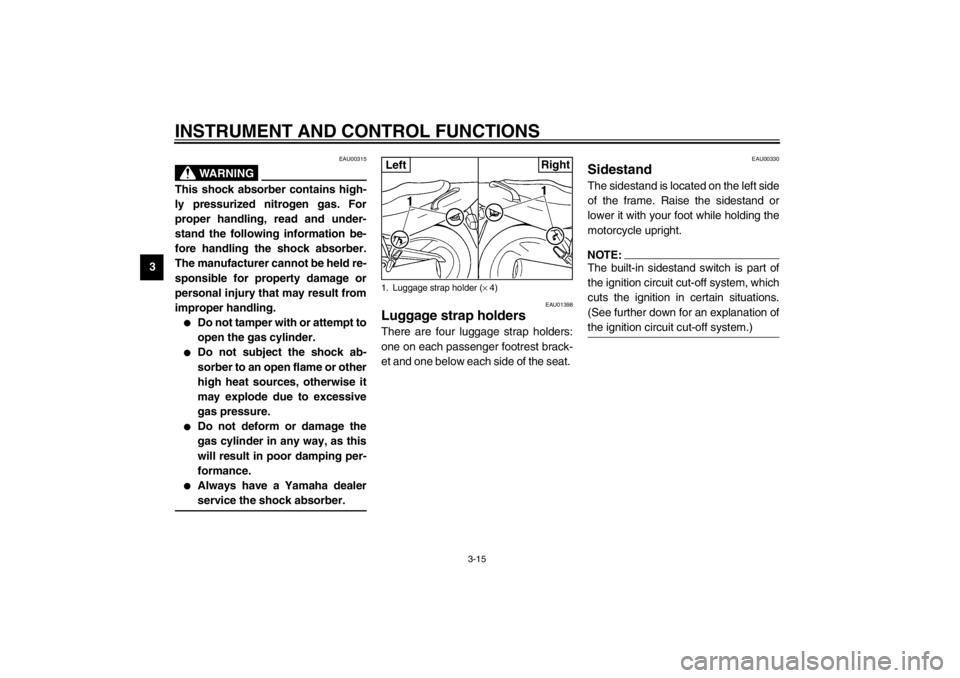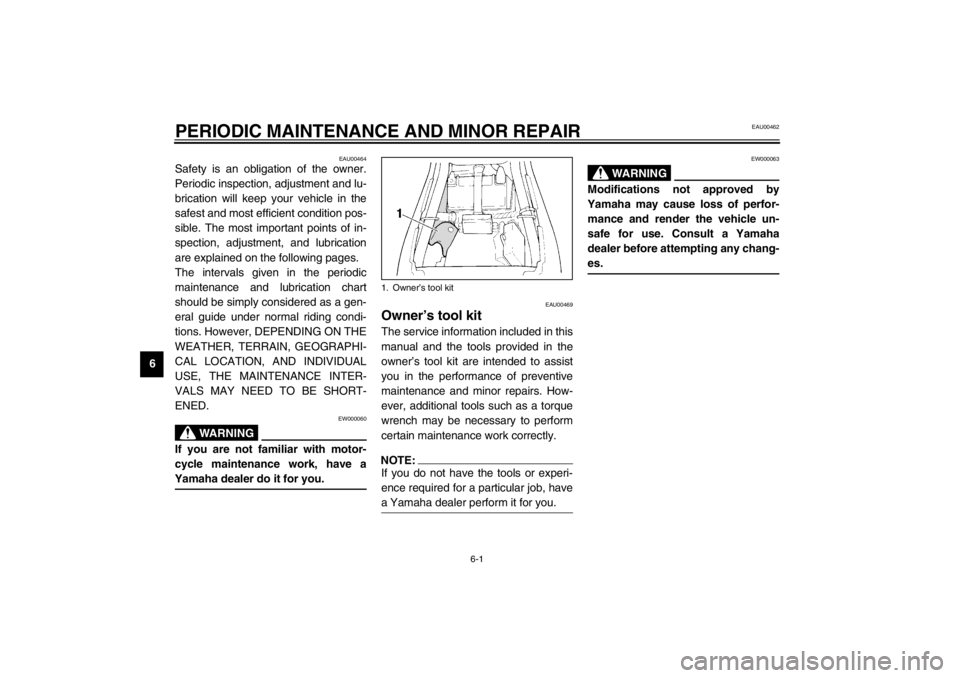Page 32 of 104
INSTRUMENT AND CONTROL FUNCTIONS
3-13
3
To install the seat
Insert the projections on the front of the
seat into the seat holder, push the rear
of the seat down to lock it in place, and
then remove the key.
NOTE:@ Make sure that the seat is properly se-
cured before riding. @
EAU02936
Helmet holders The helmet holders are located under
the seat.
To secure a helmet to a helmet holder
1. Remove the seat. (See page 3-12
for seat removal and installation
procedures.)
2. Attach the helmet to the helmet
holder, and then securely install
the seat.
EWA00015
WARNING
@ Never ride with a helmet attached to
a helmet holder, since the helmet
may hit objects, causing loss of
control and possibly an accident. @To release a helmet from a helmet
holder
Remove the seat, remove the helmet
from the helmet holder, and then install
the seat.
1. Projection (× 2)
2. Seat holder
1. Helmet holder (× 2)
E_4br.book Page 13 Wednesday, July 25, 2001 1:40 PM
Page 34 of 104

INSTRUMENT AND CONTROL FUNCTIONS
3-15
3
EAU00315
WARNING
@ This shock absorber contains high-
ly pressurized nitrogen gas. For
proper handling, read and under-
stand the following information be-
fore handling the shock absorber.
The manufacturer cannot be held re-
sponsible for property damage or
personal injury that may result from
improper handling.�
Do not tamper with or attempt to
open the gas cylinder.
�
Do not subject the shock ab-
sorber to an open flame or other
high heat sources, otherwise it
may explode due to excessive
gas pressure.
�
Do not deform or damage the
gas cylinder in any way, as this
will result in poor damping per-
formance.
�
Always have a Yamaha dealer
service the shock absorber.
@
EAU01398
Luggage strap holders There are four luggage strap holders:
one on each passenger footrest brack-
et and one below each side of the seat.
EAU00330
Sidestand The sidestand is located on the left side
of the frame. Raise the sidestand or
lower it with your foot while holding the
motorcycle upright.NOTE:@ The built-in sidestand switch is part of
the ignition circuit cut-off system, which
cuts the ignition in certain situations.
(See further down for an explanation of
the ignition circuit cut-off system.) @
1. Luggage strap holder (× 4)Left
Right
E_4br.book Page 15 Wednesday, July 25, 2001 1:40 PM
Page 35 of 104

INSTRUMENT AND CONTROL FUNCTIONS
3-16
3
EW000044
WARNING
@ The motorcycle must not be ridden
with the sidestand down, or if the
sidestand cannot be properly
moved up (or does not stay up), oth-
erwise the sidestand could contact
the ground and distract the opera-
tor, resulting in a possible loss of
control. Yamaha’s ignition circuit
cut-off system has been designed to
assist the operator in fulfilling the
responsibility of raising the side-
stand before starting off. Therefore,
check this system regularly as de-
scribed below and have a Yamaha
dealer repair it if it does not function
properly. @
EAU03741
Ignition circuit cut-off system The ignition circuit cut-off system (com-
prising the sidestand switch, clutch
switch and neutral switch) has the fol-
lowing functions.�
It prevents starting when the trans-
mission is in gear and the side-
stand is up, but the clutch lever is
not pulled.
�
It prevents starting when the trans-
mission is in gear and the clutch
lever is pulled, but the sidestand is
still down.
�
It cuts the running engine when
the transmission is in gear and the
sidestand is moved down.
Periodically check the operation of the
ignition circuit cut-off system according
to the following procedure.
EW000046
WARNING
_ �
The vehicle must be placed on
the centerstand during this in-
spection.
�
If a malfunction is noted, have a
Yamaha dealer check the sys-
tem before riding.
_
E_4br.book Page 16 Wednesday, July 25, 2001 1:40 PM
Page 39 of 104
PRE-OPERATION CHECKS
4-2
4
NOTE:_ Pre-operation checks should be made each time the motorcycle is used. Such an inspection can be accomplished in a very
short time; and the added safety it assures is more than worth the time involved. _
EWA00033
WARNING
_ If any item in the Pre-operation check list is not working properly, have it inspected and repaired before operating
the motorcycle. _Chassis fastenersMake sure that all nuts, bolts and screws are properly tightened.
Tighten if necessary.—
FuelCheck fuel level.
Fill with fuel if necessary.3-9–3-10
Lights, signals and
switchesCheck proper operation.— ITEM CHECKS PAGE
E_4br.book Page 2 Wednesday, July 25, 2001 1:40 PM
Page 42 of 104

5-1
5
EAU00372
5-OPERATION AND IMPORTANT RIDING POINTS
EAU00373
WARNING
@ �
Become thoroughly familiar
with all operating controls and
their functions before riding.
Consult a Yamaha dealer re-
garding any control or function
that you do not thoroughly
understand.
�
Never start the engine or oper-
ate it in a closed area for any
length of time. Exhaust fumes
are poisonous, and inhaling
them can cause loss of con-
sciousness and death within a
short time. Always make sure
that there is adequate ventila-
tion.
�
Before starting out, make sure
that the sidestand is up. If the
sidestand is not raised com-
pletely, it could contact the
ground and distract the opera-
tor, resulting in a possible loss
of control.
@
EAU00381*
Starting a cold engine In order for the ignition circuit cut-off
system to enable starting, one of the
following conditions must be met:�
The transmission is in the neutral
position.
�
The transmission is in gear with
the clutch lever pulled and the
sidestand up.
EW000054
WARNING
@ �
Before starting the engine,
check the function of the igni-
tion circuit cut-off system ac-
cording to the procedure
described on page 3-17.
�
Never ride with the sidestand
down.
@1. Turn the fuel cock lever to “ON”.
2. Turn the key to “ON” and make
sure that the engine stop switch is
set to “”.
3. Shift the transmission into the neu-
tral position.
NOTE:@ When the transmission is in the neutral
position, the neutral indicator light
should be on, otherwise have a
Yamaha dealer check the electrical
circuit. @4. Turn the starter (choke) on and
completely close the throttle. (See
page 3-12 for starter (choke) oper-
ation.)
5. Start the engine by pushing the
start switch.NOTE:@ If the engine fails to start, release the
start switch, wait a few seconds, and
then try again. Each starting attempt
should be as short as possible to pre-
serve the battery. Do not crank the en-
gine more than 10 seconds on any one
attempt. @
E_4br.book Page 1 Wednesday, July 25, 2001 1:40 PM
Page 43 of 104

OPERATION AND IMPORTANT RIDING POINTS
5-2
5
EC000034
CAUTION:@ The oil level warning light should
come on when the start switch is
pushed, and it should go off when
the start switch is released. If the oil
level warning light flickers or re-
mains on after starting, immediately
stop the engine, and then check the
engine oil level and the vehicle for
oil leakage. If necessary, add engine
oil, and then check the warning light
again. If the warning light does not
come on when pushing the start
switch, or if it does not go off after
starting with sufficient engine oil,
have a Yamaha dealer check the
electrical circuit. @6. After starting the engine, move the
starter (choke) lever back halfway.
ECA00045
CAUTION:@ For maximum engine life, never ac-
celerate hard when the engine is
cold! @7. When the engine is warm, turn the
starter (choke) off.NOTE:@ The engine is warm when it responds
normally to the throttle with the starter
(choke) turned off. @
EAU01258
Starting a warm engine Follow the same procedure as for start-
ing a cold engine with the exception
that the starter (choke) is not required
when the engine is warm.
E_4br.book Page 2 Wednesday, July 25, 2001 1:40 PM
Page 46 of 104
OPERATION AND IMPORTANT RIDING POINTS
5-5
5500–1,000 km
�
Avoid prolonged full-throttle oper-
ation.
�
Avoid prolonged operation above
7,000 r/min.
EC000052*
CAUTION:@ After 1,000 km of operation, the en-
gine oil must be changed and the oil
filter cartridge replaced. @1,000 km and beyond
The vehicle can now be operated
normally.
EC000053
CAUTION:@ �
Keep the engine speed out of
the tachometer red zone.
�
If any engine trouble should oc-
cur during the engine break-in
period, immediately have a
Yamaha dealer check the
vehicle.
@
EAU00460
Parking When parking, stop the engine, and
then remove the key from the main
switch.
EW000058
WARNING
@ �
Since the engine and exhaust
system can become very hot,
park in a place where pedestri-
ans or children are not likely to
touch them.
�
Do not park on a slope or on
soft ground, otherwise the
motorcycle may overturn.
@
E_4br.book Page 5 Wednesday, July 25, 2001 1:40 PM
Page 48 of 104

6-1
6
EAU00462
6-PERIODIC MAINTENANCE AND MINOR REPAIR
EAU00464
Safety is an obligation of the owner.
Periodic inspection, adjustment and lu-
brication will keep your vehicle in the
safest and most efficient condition pos-
sible. The most important points of in-
spection, adjustment, and lubrication
are explained on the following pages.
The intervals given in the periodic
maintenance and lubrication chart
should be simply considered as a gen-
eral guide under normal riding condi-
tions. However, DEPENDING ON THE
WEATHER, TERRAIN, GEOGRAPHI-
CAL LOCATION, AND INDIVIDUAL
USE, THE MAINTENANCE INTER-
VALS MAY NEED TO BE SHORT-
ENED.
EW000060
WARNING
@ If you are not familiar with motor-
cycle maintenance work, have a
Yamaha dealer do it for you. @
EAU00469
Owner’s tool kit The service information included in this
manual and the tools provided in the
owner’s tool kit are intended to assist
you in the performance of preventive
maintenance and minor repairs. How-
ever, additional tools such as a torque
wrench may be necessary to perform
certain maintenance work correctly.NOTE:@ If you do not have the tools or experi-
ence required for a particular job, have
a Yamaha dealer perform it for you. @
EW000063
WARNING
@ Modifications not approved by
Yamaha may cause loss of perfor-
mance and render the vehicle un-
safe for use. Consult a Yamaha
dealer before attempting any chang-
es. @
1. Owner’s tool kit
E_4br.book Page 1 Wednesday, July 25, 2001 1:40 PM